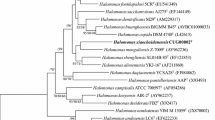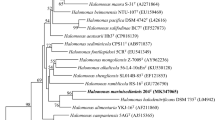Abstract
A novel Gram-negative, slightly halophilic, catalase- and oxidase-positive, obligately aerobic bacterium, strain YIM-C248T, was isolated from a sediment sample collected from a salt-lake in the Qaidam Basin in Qinghai, north-west China. Cells were non-sporulating short rods, occurring singly or as doublets, motile with peritrichous flagella. Growth occurred with 1–15% (w/v) NaCl [optimum 2–4% (w/v) NaCl], at pH 6.0–10.0 (optimum pH 7.5) and at 4–35°C (optimum 25–30°C). The major cellular fatty acids were C18:1 ω7c, C12:0 3-OH, cyclo C19:0 ω8c, C16:0 and C16:1. The predominant respiratory quinone was Q-9 and the genomic DNA G + C content was 58.6 mol%. Phylogenetic analysis based on 16S rRNA gene sequences indicated that strain YIM-C248T should be assigned to the genus Halomonas. The sequence similarities between the isolate and the type strains of members of the genus Halomonas were in the range of 92.5–97.5%. The combination of phylogenetic analysis, DNA–DNA hybridization data, phenotypic characteristics and chemotaxonomic differences supported the view that strain YIM-C248T represents a new species of the genus Halomonas, for which the name Halomonas sediminis sp. nov. is proposed, with YIM-C248T (=CCTCC AA 207031 = KCTC 22167) as the type strain.

Similar content being viewed by others
References
Arahal DR, Vreeland RH, Litchfield CD, Mormile MR, Tindall BJ, Oren A, Bejar V, Quesada E, Ventosa A (2007) Recommended minimal standards for describing new taxa of the family Halomonadaceae. Int J Syst Evol Microbiol 57:2436–2446
Chen YG, Jiang Y, Li WJ, Cui XL, Xu LH (2007a) Microbial diversity and screening of antitumor activity of actinomycete strains from saline and alkaline environments in the Qinghai Province, PR China. Acta Microbiol Sin 47:757–762
Chen YG, Cui XL, Pukall R, Li HM, Yang YL, Xu LH, Wen ML, Peng Q, Jiang CL (2007b) Salinicoccus kunmingensis sp. nov., a moderately halophilic bacterium isolated from a salt mine in Yunnan, south-west China. Int J Syst Evol Microbiol 57:2327–2332
Chen YG, Cui XL, Fritze D, Chai LH, Schumann P, Wen ML, Wang YX, Xu LH, Jiang CL (2008a) Virgibacillus kekensis sp. nov., a moderately halophilic bacterium isolated from a salt lake in China. Int J Syst Evol Microbiol 58:647–653
Chen YG, Cui XL, Kroppenstedt RM, Stackebrandt E, Wen ML, Xu LH, Jiang CL (2008b) Nocardiopsis quinghaiensis sp. nov., isolated from saline soil in China. Int J Syst Evol Microbiol 58:699–705
Chen YG, Cui XL, Li WJ, Xu LH, Wen ML, Peng Q, Jiang CL (2008c) Salinicoccus salitudinis sp. nov., a new moderately halophilic bacterium isolated from a saline soil sample. Extremophiles 12:197–203
Cowan ST, Steel KJ (1965) Manual for the identification of medical bacteria. Cambridge University Press, London
Cui XL, Mao PH, Zeng M, Li WJ, Zhang LP, Xu LH, Jiang CL (2001) Streptomonospora salina gen. nov., sp. nov., a new member of the family Nocardiopsaceae. Int J Syst Evol Microbiol 51:357–363
Dobson SJ, Franzmann PD (1996) Unification of the genera Deleya (Baumann et al. 1983), Halomonas (Vreeland et al. 1980), and Halovibrio (Fendrich 1988) and the species Paracoccus halodenitrificans (Robinson and Gibbons 1952) into a single genus, Halomonas, and placement of the genus Zymobacter in the family Halomonadaceae. Int J Syst Bacteriol 46:550–558
Ezaki T, Hashimoto Y, Yabuuchi E (1989) Fluorometric deoxyribonucleic acid-deoxyribonucleic acid hybridization in microdilution wells as an alternative to membrane filter hybridization in which radioisotopes are used to determine genetic relatedness among bacterial strains. Int J Syst Bacteriol 39:224–229
Felsenstein J (1981) Evolutionary trees from DNA sequences: a maximum likelihood approach. J Mol Evol 17:368–376
Felsenstein J (1985) Confidence limits on phylogenies: an approach using the bootstrap. Evolution 39:783–791
Felsenstein J (2002) PHYLIP (Phylogeny Inference Package), version 3.6a. Distributed by the auther. Department of Genome Science, University of Washington, Seattle
Fendrich C (1988) Halovibrio variabilis gen. nov. sp. nov., Pseudomonas halophila sp. nov. and a new halophilic aerobic coccoid Eubacterium from Great Salt Lake, Utah, USA. Syst Appl Microbiol 11:36–43
Gregersen T (1978) Rapid method for distinction of Gram-negative from Gram-positive bacteria. Eur J Appl Microbiol Biotechnol 5:123–127
Groth I, Schumann P, Weiss N, Martin K, Rainey FA (1996) Agrococcus jenensis gen. nov., sp. nov., a new genus of actinomycetes with diaminobutyric acid in the cell wall. Int J Syst Bacteriol 46:234–239
Hopwood DA, Bibb MJ, Chater KF, Kieser T, Bruton CJ, Kieser HM, Lydiate DJ, Smith CP, Ward JM (1985) Preparation of chromosomal, plasmid and phage DNA. In: Hopwood DA, Bibb MJ, Chater KF, Kieser T, Bruton CJ, Kieser HM, Lydiate DJ, Smith CP, Ward JM, Schrempf H (eds) Genetic manipulation of Streptomyces: a laboratory manual. F. Crowe and Sons, Norwich, pp 79–80
Kaye JZ, Márquez MC, Ventosa A, Baross JA (2004) Halomonas neptunia sp. nov., Halomonas sulfidaeris sp. nov., Halomonas axialensis sp. nov. and Halomonas hydrothermalis sp. nov.: halophilic bacteria isolated from deep-sea hydrothermal-vent environments. Int J Syst Evol Microbiol 54:499–511
Kim KK, Jin L, Yang HC, Lee ST (2007) Halomonas gomseomensis sp. nov., Halomonas janggokensis sp. nov., Halomonas salaria sp. nov. and Halomonas denitrificans sp. nov., moderately halophilic bacteria isolated from saline water. Int J Syst Evol Microbiol 57:675–681
Kimura M (1980) A simple method for estimating evolutionary rates of base substitutions through comparative studies of nucleotide sequences. J Mol Evol 16:111–120
Kluge AG, Farris FS (1969) Quantitative phyletics and the evolution of anurans. Syst Zool 18:1–32
Kumar S, Tamura K, Nei M (2004) MEGA3: integrated software for molecular evolutionary genetics analysis and sequence alignment. Brief Bioinform 5:150–163
Kushner DJ (1993) Growth and nutrition of halophilic bacteria. In: Vreeland RH, Hochstein LI (eds) The biology of halophilic bacteria. CRC, Boca Raton, pp 87–103
Lim JM, Jeon CO, Song SM, Kim CJ (2005) Pontibacillus chungwhensis gen. nov., sp. nov., a moderately halophilic Gram-positive bacterium from a solar saltern in Korea. Int J Syst Evol Microbiol 55:165–170
Mata JA, Martínez-Cánovas MJ, Quesada E, Bèjar V (2002) A detailed phenotypic characterization of the type strains of Halomonas species. Syst Appl Microbiol 25:360–375
Mesbah M, Premachandran U, Whitman WB (1989) Precise measurement of the G + C content of deoxyribonucleic acid by high-performance liquid chromatography. Int J Syst Bacteriol 39:159–167
Quillaguamán J, Hatti-Kaul R, Mattiasson B, Alvarez MT, Delgado O (2004) Halomonas boliviensis sp. nov., an alkalitolerant, moderate halophile isolated from soil around a Bolivian hypersaline lake. Int J Syst Evol Microbiol 54:721–725
Saitou N, Nei M (1987) The neighbor-joining method: a new method for reconstructing phylogenetic trees. Mol Biol Evol 4:406–425
Sasser M (1990) Identification of bacteria by gas chromatography of cellular fatty acids. USFCC Newsl 20:16
Shirling EB, Gottlieb D (1966) Methods for characterization of Streptomyces species. Int J Syst Bacteriol 16:313–340
Smibert RM, Krieg NR (1981) General characterization. In: Gerhardt P, Murray RGE, Costilow RN, Nester EW, Wood WA, Krieg NR, Phillips GB (eds) Manual of methods for general microbiology. American Society for Microbiology, Washington, pp 409–443
Smibert RM, Krieg NR (1994) Phenotypic characterization. In: Gerhardt P, Murray RGE, Wood WA, Krieg NR (eds) Methods for general and molecular bacteriology. American Society for Microbiology, Washington, pp 607–654
Stackebrandt E, Goebel BM (1994) Taxonomic note: a place for DNA-DNA reassociation and 16S rRNA sequence analysis in the present species definition in bacteriology. Int J Syst Bacteriol 44:846–849
Thompson JD, Gibson TJ, Plewniak F, Jeanmougin F, Higgins DG (1997) The CLUSTAL_X windows interface: flexible strategies for multiple sequence alignment aided by quality analysis tools. Nucleic Acids Res 25:4876–4882
Ventosa A, Quesada E, Rodriguez-Valera F, Ruiz-Berraquero F, Ramos-Cormenzana A (1982) Numerical taxonomy of moderately halophilic Gram-negative rods. J Gen Microbiol 128:1959–1968
Vreeland RH, Litchfield CD, Martin EL, Elliot E (1980) Halomonas elongata, a new genus and species of extremely salt tolerant bacteria. Int J Syst Bacteriol 30:485–495
Wayne LG, Brenner DJ, Colwell RR, Grimont PAD, Kandler O, Krichevsky MI, Moore LH, Moore WEC, Murray RGE et al (1987) International committee on systematic bacteriology. Report of the ad hoc committee on reconciliation of approaches to bacterial systematics. Int J Syst Bacteriol 37:463–464
Xu XW, Wu YH, Zhou Z, Wang CS, Zhou YG, Zhang HB, Wang Y, Wu M (2007) Halomonas saccharevitans sp. nov., Halomonas arcis sp. nov. and Halomonas subterranea sp. nov., halophilic bacteria isolated from hypersaline environments of China. Int J Syst Bacteriol 57:1619–1624
Acknowledgments
This work was supported by grants from the National Natural Science Foundation of China (NSFC) (30860013, 30660004, 30760006), the Ministry of Science and Technology of China (863 Program, no. 2007AA021306), Jishou University (jsdxkyzz200801, 07JDPHE148, 07JDPHE150, 07JDPHE151, 07JDPHE153), and the Yunnan Provincial Sciences and Technology Department (2005PY01-1, 2006C0006M). We are grateful to Mr. Huai-Dong Xiao and Mr. Ke Huang for their excellent technical assistance.
Author information
Authors and Affiliations
Corresponding authors
Additional information
Communicated by H. Santos.
The GenBank/EMBL/DBBJ accession number for the 16S rRNA gene sequence of strain YIM-C248T is EU135707.
Rights and permissions
About this article
Cite this article
Huang, HY., Chen, YG., Wang, YX. et al. Halomonas sediminis sp. nov., a new halophilic bacterium isolated from salt-lake sediment in China. Extremophiles 12, 829–835 (2008). https://doi.org/10.1007/s00792-008-0189-z
Received:
Accepted:
Published:
Issue Date:
DOI: https://doi.org/10.1007/s00792-008-0189-z




